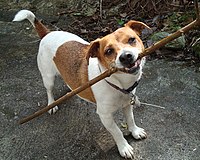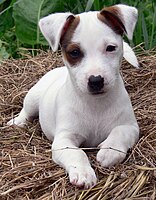
The American Kennel Club (AKC) is a registry of purebred dog pedigrees in the United States. In addition to maintaining its pedigree registry, this kennel club also promotes and sanctions events for purebred dogs, including the Westminster Kennel Club Dog Show, an annual event which predates the official forming of the AKC, the National Dog Show and the AKC National Championship. The AKC is a non-member partner with the Fédération Cynologique Internationale. The AKC recognizes 200 dog breeds, as of 2022.

The Scottish Terrier, popularly called the Scottie, is a breed of dog. Initially one of the highland breeds of terrier that were grouped under the name of Skye Terrier, it is one of five breeds of terrier that originated in Scotland, the other four being the modern Skye, Cairn, Dandie Dinmont, and West Highland White terriers. They are an independent and rugged breed with a wiry outer coat and a soft dense undercoat. The first Earl of Dumbarton nicknamed the breed "the diehard". According to legend, the Earl of Dumbarton gave this nickname because of the Scottish Terriers' bravery, and Scotties were also the inspiration for the name of his regiment, The Royal Scots, Dumbarton’s Diehard. Scottish Terriers were originally bred to hunt vermin on farms.

The Patterdale Terrier is a breed "type" of dog descended from the Northern terrier breeds of the early 18th century. Bred in Patterdale, Lake District.
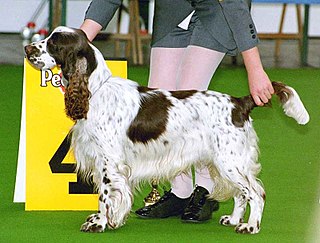
A dog show is an animal show, an event where dogs are exhibited. A conformation show, also referred to as a breed show, is a kind of dog show in which a judge, familiar with a specific dog breed, evaluates individual purebred dogs for how well the dogs conform to the established breed type for their breed, as described in a breed's individual breed standard.

Fox Terriers are two different breeds of the terrier dog type: the Smooth Fox Terrier and the Wire Fox Terrier. Both of these breeds originated in the 19th century from a handful of dogs who are descended from earlier varieties of British terriers, and are related to other modern white terrier breeds. In addition, a number of breeds have diverged from these two main types of fox terrier and have been recognised separately, including the Jack Russell Terrier, Miniature Fox Terrier and Rat Terrier. The Wire and Smooth Fox Terriers share similar characteristics, the main differences being in the coat and markings. They have been successful in conformation shows, more prominently in America than their homeland.
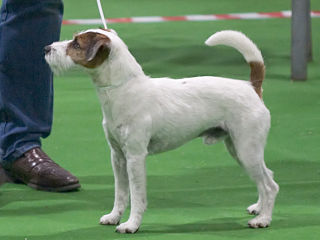
The Parson Russell Terrier is a breed of small white terrier that was the original Fox Terrier of the 18th century. The breed is named after the Reverend Jack Russell, credited with the creation of this type of dog. It is the recognised conformation show variety of the Jack Russell Terrier and was first recognised in 1990 in the United Kingdom as the Parson Jack Russell Terrier. In America, it was first recognised as the Jack Russell Terrier in 1997. The name was changed to its current form in 1999 in the UK and by 2008 all international kennel clubs recognised it under the new name.
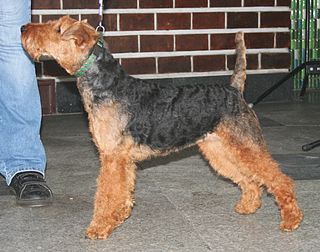
The Welsh Terrier originates from Wales and was originally bred for hunting fox, rodents and badger; but during the last century, it has mainly been bred for showing. Despite this, it has retained its terrier strength of character. The Welsh Terrier has been claimed to be the oldest existing dog breed in the UK.

The Sealyham Terrier is a rare Welsh breed of small to medium-sized terrier that originated in Wales as a working dog. It is principally a white-bodied, rough-coated breed, developed in the mid-to-late-19th century by Captain John Edwardes at Sealyham House, Pembrokeshire.

The Lakeland Terrier is a dog breed, which takes its name from its place of origin, the Lake District in England. The dog is a small to mid-size member of the Terrier family. While independent in personality, it interacts well with owners and all family members, and is mostly hypo-allergenic. In the United Kingdom, the Lakeland Terrier is considered a vulnerable dog breed at risk of going extinct through low levels of breeding, according to The Kennel Club. In the United States, the Lakeland Terrier ranked 148 out of 193 breeds by number of American Kennel Club puppy registrations in 2019.

The Toy Fox Terrier is a small terrier breed of dog, directly descended from the larger Smooth Fox Terrier but since 1936, it has been registered in the USA with the UKC as a separate breed.

John Russell, was an English parson who served as vicar of Swimbridge from 1832 to 1872. An enthusiastic fox-hunter and dog breeder, Russell developed the Jack Russell Terrier and the Parson Russell Terrier, both of which are a variety of the Fox Terrier breed.

The Smooth Fox Terrier is a breed of dog, one of many terrier breeds. It was the first breed in the fox terrier family to be given official recognition by The Kennel Club. It is well known, and although not a widely popular breed today outside hunting and show circles, it is extremely significant due to the large number of terriers believed descended from the breed.

The Teddy Roosevelt Terrier is a small to medium-sized American hunting terrier. It is lower-set, with shorter legs, and is more muscular with heavier bone density than the related American Rat Terrier. Much diversity exists in the history of the Teddy Roosevelt Terrier breed, and it shares a common early history with the American Rat Terrier, Fox Paulistinha, and Tenterfield Terrier. The Rat Terrier's background is said to stem from the terriers or other dogs that were brought over by early English and other working-class immigrants. Since the breed was a farm, hunting, and utility dog, little to no planned breeding was used other than breeding dogs with agreeable traits to each other to produce the desired work ethic in the dog. The Feist (dog), Bull Terrier, Smooth Fox Terrier, Manchester Terrier, Whippet, Italian Greyhound, the now extinct English White Terrier, Turnspit Dog, and Wry-legged Terrier all share in the Teddy Roosevelt Terrier's ancestry. These early ratting terriers were then most likely bred to the Beagle or Beagle crossbred dogs and other dogs. Maximizing the influences from these various breeds provides the modern Teddy Roosevelt Terrier with a keen sense of awareness and prey drive, an acute sense of smell, and a very high intellect. Although they tend to be aloof with strangers, they are devoted companion dogs with a strong desire to please and be near their owners at all times.

The Lancashire Heeler is a small breed of dog developed for use as a drover and herder of cattle. The Lancashire Heeler is listed by the Kennel Club (UK) as an endangered breed. The breed was recognized by the American Kennel Club in 2024.

The Ratonero Bodeguero Andaluz is a Spanish breed of dog of the terrier type. Its name reflects its main occupation: hunting rats and mice hidden between barrels in the wineries of Andalusia in Spain. It was recognised as an indigenous Spanish breed in 2000 by the Spanish Ministry of Agriculture and by the Spanish Kennel Club, the Real Sociedad Canina de España.

A feist is a small hunting dog. This group descended from the terriers brought over to the United States by British miners and other immigrants. These terriers probably included crosses between the Smooth Fox Terrier, the Manchester Terrier, and the now-extinct English White Terrier. These dogs were used as ratters, and gambling on their prowess in killing rats was a favorite hobby of their owners. Some of these dogs have been crossed with Greyhounds, Whippets or Italian Greyhounds, and Beagles or other hounds — extending the family to include a larger variety of purpose than the original ratter, or Rat Terrier.

A working terrier is a terrier bred to hunt small mammals, such as badgers or foxes. According to the Oxford English Dictionary, the name dates back to 1425 and is derived from the French chien terrier, 'digging dog', which is from the Medieval Latin terrarius, ultimately from the Latin terra (earth).
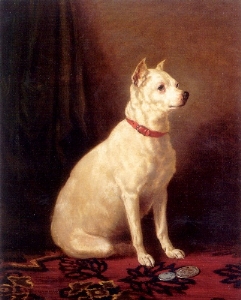
The English White Terrier is an extinct breed of dog. "English White Terrier" is the failed show ring name of a pricked-ear form of the white fox-working terriers that have existed in Great Britain since the late 18th century.






